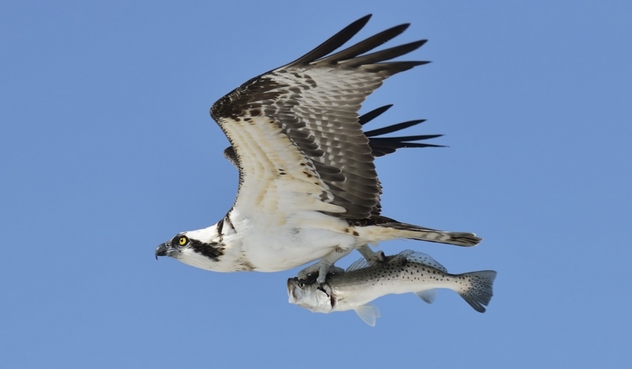 Music
Music  Music
Music  History
History 10 Less Than Jolly Events That Occurred on December 25
 Weird Stuff
Weird Stuff 10 Funny Ways That Researchers Overthink Christmas
 Politics
Politics 10 Political Scandals That Sent Crowds Into the Streets
 Weird Stuff
Weird Stuff Ten Bizarre Facts About The Doge Meme
 Our World
Our World 10 Ways Your Christmas Tree Is More Lit Than You Think
 Movies and TV
Movies and TV The 10 Coolest Stars to Set Sail on The Love Boat
 History
History 10 Things You Didn’t Know About the American National Anthem
 Technology
Technology Top 10 Everyday Tech Buzzwords That Hide a Darker Past
 Humans
Humans 10 Everyday Human Behaviors That Are Actually Survival Instincts
 Music
Music 10 Surprising Origin Stories of Your Favorite Holiday Songs
 History
History 10 Less Than Jolly Events That Occurred on December 25
 Weird Stuff
Weird Stuff 10 Funny Ways That Researchers Overthink Christmas
Who's Behind Listverse?

Jamie Frater
Head Editor
Jamie founded Listverse due to an insatiable desire to share fascinating, obscure, and bizarre facts. He has been a guest speaker on numerous national radio and television stations and is a five time published author.
More About Us Politics
Politics 10 Political Scandals That Sent Crowds Into the Streets
 Weird Stuff
Weird Stuff Ten Bizarre Facts About The Doge Meme
 Our World
Our World 10 Ways Your Christmas Tree Is More Lit Than You Think
 Movies and TV
Movies and TV The 10 Coolest Stars to Set Sail on The Love Boat
 History
History 10 Things You Didn’t Know About the American National Anthem
 Technology
Technology Top 10 Everyday Tech Buzzwords That Hide a Darker Past
 Humans
Humans 10 Everyday Human Behaviors That Are Actually Survival Instincts
10 Completely Bizarre Bird Facts
Birds are everywhere, but their lives are sometimes exceedingly unusual. Birds should never be taken for granted, and closer observation reveals just how odd they really are. Among birds we find some of the most surprising, weird, or even human-like traits in the animal kingdom.
10Bassian Thrush Feeds By Flatulence

Thrushes, including robins, are among the most average-looking birds. They are also among the world’s most widely distributed and successful birds. These midsize songbirds are found on lawns and in parks worldwide, looking (and not listening, as is commonly believed) for worms with a cocked head. There is a species of thrush from Australia that feeds by using flatulence to flush out worms.
The bassian thrush actually directs a stream of flatulence toward the site of a worm find. The gas apparently disturbs the worm and provokes movement. The otherwise ordinary-looking thrush is then able to effectively locate the worm and grab it for a quick meal. Producing gas on repeated occasions while feeding is certainly one of the most bizarre known adaptations of physiology and bird behavior.
Love reading about the bizarre feathered oddities of the natural world? Discover dozens of crazy birds just like these when you buy Extreme Birds: The World’s Most Extraordinary and Bizarre Birds at Amazon.com!
9Blue Tits Steal Milk

Blue tits are European songbirds comparable to chickadees, with relatively close genetic ties to crows, magpies, and ravens. Despite their small size, these sociable birds are highly intelligent and adaptive, capable of complex behaviors and interactions with their environment. In certain UK towns, blue tits developed a novel feeding strategy at the expense of humans. Following milk delivery people, blue tits puncture the foil lids with their bills before extracting small amounts of milk from the bottles filled nearly to the top.
Although the amount of milk taken is minuscule, serious contamination can easily result. European robins are a second species of garden songbird found to take milk from bottles after they are pecked open. These species are far less effective in their efforts than the tits, however. Unfortunately, tits are poorly adapted to milk digestion, and there were cases where some have even fallen into bottles and drowned.
8The Beautiful Vulture

The lammergeyer, or bearded vulture, is one of the most distinctive and awe-inspiring birds of prey, frequently feeding on the marrow of shattered bones dropped from a height. However, it is not so much the diet of this strange bird but its habit of dyeing its feathers in the interest of appearance that make it so remarkable. According to leading research on lammergeyers, the birds are known to dye their feathers with natural substances, beginning at about seven years of age.
By immersing their naturally whitish or beige breast feathers and facial regions in iron-rich mud and mineralized clay, the vultures add colorful “highlights” to their plumage—just like humans using hair styling products. Vultures feeding on dead animal products lack the rich carotenoid pigments that color plumage in many plant-eating birds. Red pigments signal dominance in the bird world. It is thought that lammergeyers assert their social status and rank through their self-coloring habits.
7Common Poorwill—Bird Hibernation

When hibernation is mentioned, we usually think of bears, or perhaps a frog at the bottom of a pond. Birds fly south, or stay in colder regions and survive by feeding on more innovative food sources. However, certain birds—such as swifts and hummingbirds—seem to have the ability to slow down their metabolism on cold nights. One species of nightjar, related to the whip-poor-will and the so-called “goatsuckers,” takes it further.
The common poorwill of the American West patrols arid landscapes for insect prey. Uniquely among birds, this species actually goes into a full state of hibernation as the cool desert landscape becomes devoid of insect life during the winter season. The poorwills wedge themselves into desert rock crevices and wait out the winter in a manner very similar to a bear, waking up to resume their nocturnal foraging as the weather warms in the spring. No other bird actually undertakes a full hibernation. Even the closely related nighthawks simply fly south.
Discover hundreds of species of birds in your area with Birds of North America: A Guide To Field Identification at Amazon.com!
6Canyon Wren—The Patio Decorator

Wrens are some of the most delightful and frequently appreciated garden birds. Primarily restricted to North and South America as a family, the 80 or so species of wrens have adapted to a vast range of opposite habitats despite their similar forms. The rusty-backed, slim-built canyon wren is a native of western North America that inhabits dry, arid slopes with rocks, pebbles, and crevices. In an example of avian engineering, these somewhat strange birds actually move a number of small stones to form a pathway, or patio of sorts, in front of their nest sites.
Usually built by females, the “patios” may include a whopping 300 stones. Despite extensive research on canyon wrens and a lot of attention from naturalists, the purpose and function of the bizarre stone paths constructed by the birds remain a mystery. Scientists from the University of Colorado embarked on a study that may shed light on the purpose of the nests. Cameras placed near nest sites may allow observation of how the paths are used.
5Use Of Disinfecting Plants In Bird Nests

Blue tits aren’t only known for drinking milk from tampered bottles. These small songbirds seem to practice herbal and even aromatherapy skills, to quote a tongue-in-cheek reference by avian scientists studying these birds. Multiple species, including starlings and blue tits, place small pieces of aromatic plants in their nest. However, the blue tits are unique in using numerous plant species that have the effect of reducing harmful bacteria. Blowfly infestations are a key problem in their nests, and sanitary problems may lead to chick mortality. The presence of small pieces of plants was found to reduce rates of bacteria infestation among nestlings.
Researchers publishing results discovered that “aromatic plants, including lavender (Lavandula stoechas), apple mint (Mentha suaveolens), the curry plant (Helichrysum itlaicum) and Achillea ligustica significantly change the composition of bacterial communities living on blue tit nestlings.” The plants were also found to positively affect red blood cell counts.
4Seabird And Duck Piracy
Many birds are highly skilled in foraging. After all, the survival of many bird species in challenging environments would be tenuous were it not for their truly remarkable ways of finding food. Several species of birds, primarily the water-dwelling types, are known for their repeated robberies of other bird species. Kleptoparasites can be divided into specialists, who use theft and intimidation as a primary foraging technique, and occasional or opportunistic kleptoparasites that take food from other birds on a more casual basis.
Jaegers, skuas, and frigatebirds are aggressive seabirds that repeatedly harass other seabirds until they disgorge their latest meal. The birds then catch the food in midair and fly off. In a slightly odder twist, American wigeons—perfectly capable of feeding on their own—are known to swim up to canvasbacks or coots diving for wild celery and snatch their food away. The reason? American wigeons can’t dive as effectively as those they steal from, but they want the benefits of the lifestyle.
3Swainson’s Thrush And Its Mating Game

I selected the Swainson’s thrush for graduate research with Royal Roads University in British Columbia, due to its apparent usefulness as an indicator of bird sensitivity to changing habitat conditions. However, this strikingly ordinary-looking yet beautiful bird has an unexpected twist to its life history. Swainson’s thrush males take a rather unconventional approach to mating.
Arriving in North America from South American wintering grounds, male thrushes claim territories in mixed forests, which they then aggressively defend against female birds. After playing “hard to get” and having their territorial boundaries breached by females, the reluctant male birds allow the female birds into their territory. The thrushes are quite loyal compared to many songbirds and may take the same mates year after year. This is thought to facilitate quicker pairing for greater nesting success in a short breeding season.
2The Tense Truce Between Alligators And Herons

Herons and alligators would seem to be neutral toward each other in their ecological roles in subtropical wetlands. If interaction was considered, they might appear to be deadly enemies, with the herons being placed at considerable risk of predation. However, there is a more complex and surprisingly beneficial relationship between wading birds and alligators in the Florida Everglades.
Wetland vegetation grows rapidly in the open water of the highly productive wetland environments. Alligator foraging activity creates open pools by crushing this vegetation. As a result, fish can be easily captured in these pools, which contributes to the foraging needs of herons. Additionally, alligators offer protection from rats and mammals that would otherwise eat the eggs from herons’ nests. Alligators do take some young herons as prey on occasion, when the latter fall from their nests. However, it is thought that the alligators’ presence benefits the herons enough to outweigh the costs.
1Osprey’s Fish Transportation Tactics

The osprey is a one-of-a-kind bird of prey found near water on every continent (excluding Antarctica). Unlike many birds of prey, this species is classified in its own genus and has no close relatives. Similar to a fish eagle, the osprey plunges into the water and seizes rather large fish in its specially padded, extra-long, “grip assist” piercing talons before flying off to a perch. Viewers may be struck by how perfectly aligned the fish is when carried: Ospreys resemble an airplane with a bomb or fuel tank in profile.
In fact, ospreys almost always carry fish parallel to their bodies to improve aerodynamics and in-flight handling, despite the handicap of the heavy and awkward load. Unlike most birds, the osprey has a reversible outer toe, which allows the bird to carry prey with two toes facing forward and two facing backward. This makes aerodynamic carrying a lot easier.
Christopher Stephens is a graduate student in environmental sciences at Royal Roads University and Listverse writer. He pursues amazing birding experiences and has a special interest in ecology and animal adaptations. His individualized or group birding tours are available in British Columbia, Canada.








